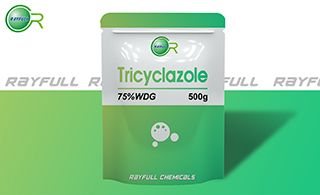Tricyclazole
    三环唑 三环唑
Introduction: Tricyclazole is a systemic fungicide, absorbed rapidly by the roots, with translocation through the plant. Control of rice blast(Pyricularia oryzae)in transplanted and direct-seeded rice. Can be applied as a flat drench,transplant root soak,or foliar application.One or 2 applications by one or more of these methods give a season-long control of the disease.
Common name: Tricyclazole
Another name: Tricyclazone; Blascide; Beam; Sivic; Pilarblas; Tizole; Trizole; Elanco 291; Blas-T; Caswell No. 884C; Tricyclazol; 2,7,8,9-Tricyclazole; etc.
Chemical name: 5-methyl-1,2,4-triazolo[3,4-b][1,3]benzothiazole
Empirical formula: C9H7N3S
Structural formula:

Mol. Weight: 189.24 g/mol
CAS No.: 41814-78-2
Specifications
Leading Tricyclazole supplier
Tricyclazole 95% TC
Tricyclazole 75% WP&WDG
Tricyclazole 20% WP
Packing:
BULK PACKING
Powder: 25kg/Bag, 25kg/Drum, 50kg/Drum etc.
Liquid: 200L/Drum, 20L/Drum, 10L/Drum etc.
SMALL PACKING
Powder: 1kg/Alu bag, 500g/Alu bag, 200g/Alu bag, 100g/Alu bag, 50g/Alu bag, 15g/Alu bag etc.
Liquid: 5L/Drum, 1L/Bottle, 500ml/Bottle, 250ml/Bottle, 100ml/Bottle, 50ml/Bottle etc.
Customerized packing label
Tricyclazole FAO standard
Professional registration
HAZARDS IDENTIFICATION
Hazard statement(s)
H301 (31.33%): Toxic if swallowed.
H302 (68.67%): Harmful if swallowed.
H411 (31.33%): Toxic to aquatic life with long lasting effects.
Precautionary statement(s)
P264: Wash skin thoroughly after handling.
P270: Do not eat, drink or smoke when using this product.
P273: Avoid release to the environment.
P301+P310: IF SWALLOWED: Immediately call a POISON CENTER/doctor/...
P301+P312: IF SWALLOWED: call a POISON CENTER/doctor/... IF you feel unwell.
P321: Specific treatment (see supplemental first aid instructions on this label).
P330: Rinse mouth.
P391: Collect spillage.
P405: Store locked up.
P501: Dispose of contents/container to an approved waste disposal plant.
Supplemental Hazard Statements: none.
MAMMALIAN TOXICOLOGY
Acute toxicity: 1) Acute oral LD50 for rats is 237 mg/kg. 2) Acute dermal LD50 for rats is >5000 mg/kg. 3) Acute inhalation toxicity LC50 (4 h) for rats is >0.52 mg/L (nose only). 4) Skin irritation: Non-irritating to skin (rabbits). 5) Eye irritation: Non-irritating to eyes (rabbits). 6) Skin sensitization for guinea pig: Non-sensitizing.
NOEL: (2 y) for mice is 6.67 mg/kg/day; (1 y) for dogs is 15 mg/kg/day. Other No evidence of carcinogenic potential in mice.
ADI 0-0.03 mg/kg b.w.
Classification:
WHO Classification: II (Moderately hazardous)
EC Risk Classification: Xn - Harmful: R22
US EPA Classification (formulation): II (Warning - Moderately toxic)
ECOTOXICOLOGY
Effect on birds: Acute oral LD50 for Mallard is >1528 mg/kg. Effect on fish: Acute LC50 (96 h) for Rainbow trout is 7.3 mg/l. Effects on aquatic invertebrates: Acute EC50 (48 h) for Daphnia magna is 34 mg/l. Effects on algae: Acute 72 hour EC50 for Pseudokirchneriella subcapitata is 8.2 mg/l. Effects on bees: contact acute 48 hour LD50 is >100 μg/bee, oral acute 48 hour LD50 is >88.5 μg/bee. Effects on earthworms: Acute 14 day LC50 is >1000 mg/kg.
ENVIRONMENTAL FATE
Animals Rapid and extensive metabolism. Plants The principal metabolite in plants is the hydroxymethyl analogue. Soil/Environment Kd 4 (loamy sand, pH 6.5, 1.5% o.m.), 45 (loam, pH 5.7, 3.1% o.m.), 21 (clay loam, pH 7.4, 1.9% o.m.), 22 (silty clay loam, pH 5.7, 4.1% o.m.).
Usage: Tricyclazole was introduced in Philippines (1976) by Eli Lilly & Co. (agrochemical interests now Dow AgroSciences). It is a fungicide used mainly for prolonged control of rice blast.
Application: Biochemistry Melanin biosynthesis inhibitor (reduction of 1,3,8-trihydroxynaphthalene and vermelone). Mode of action Systemic fungicide, absorbed rapidly by the roots, with translocation through the plant. Uses Control of rice blast (Pyricularia oryzae) in transplanted and direct-seeded rice at 100 g/ha. Can be applied as a flat drench, transplant root soak, or foliar application. One or two applications by one or more of these methods give a season-long control of the disease.
| 






